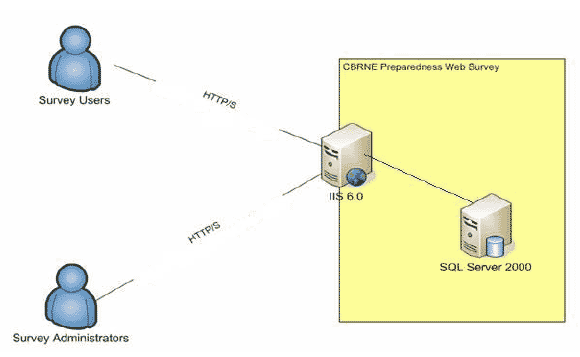
The Operations Manual identifies and describes hardware and software requirements to set up a .NET architecture Web site. The manual includes the files and steps that will allow a Federal- or State-level IT administrator to deploy the Web questionnaire site for the Preparedness for Chemical, Biological Radiological, Nuclear, and Explosive (CBRNE) Events: Questionnaire for Health Care Facilities.
The CBRNE Preparedness Questionnaire is a Web-enabled data collection tool. It enables users to submit information about their hospital facilities using a Web browser. A separate survey administration site enables a survey administrator to log in and view the number of submitted questionnaires, change his/her password, and download submitted questionnaire data. The survey site was developed on the .NET platform.
Figure 1 illustrates where the hardware is located and how it communicates.

The list below describes the general design decisions for the application:
The Web site can run on a single server that has IIS 6.0 and SQL Servers installed on it, or it can be run on a standalone Web server that utilizes a SQL Server on a different server. Both servers require a Microsoft Windows Server operating system (OS). The following table describes the recommended hardware for the Windows Server 2003 Standard Edition or higher:
| Component | Requirement |
|---|---|
| Computer and processor | 133-MHz or faster processor for x86-based PCs; 733-MHz for Itanium-based PCs; up to eight processors supported on either the 32-bit or the 64-bit version |
| Memory | 128 MB of RAM minimum required; maximum: 32 GB for x86-based PCs with the 32-bit version and 64 GB for Itanium-based PCs with the 64-bit version |
| Hard disk | 1.5 GB of available hard-disk space for x86-based PCs; 2 GB for Itanium-based PCs; additional space is required if installing over a network |
| Component | Requirement |
|---|---|
| Computer and processor | 133-MHz or faster processor for x86-based PCs; 733-MHz for Itanium-based PCs; up to eight processors supported on either the 32-bit or the 64-bit version |
| Memory | 128 MB of RAM minimum required; maximum: 32 GB for x86-based PCs with the 32-bit version and 64 GB for Itanium-based PCs with the 64-bit version |
| Hard disk | 1.5 GB of available hard-disk space for x86-based PCs; 2 GB for Itanium-based PCs; additional space is required if installing over a network |
| Operating System for Web and Database Servers | Windows 2000 Server or Windows 2003 Server |
|---|---|
| Database Server | SQL Server 2000 Standard Edition |
For the Web server: If you have been directed to do a server installation, you must have the following software installed in addition to the typical installation requirements:
Note: If you have existing hardware/software for the .NET 1.1 Web server/SQL server, such as Windows 2000 server with 1.1 NET framework and MDAC properly installed, the application should operate. Server install and configuration should include all known Microsoft recommended security patches.
The Web server should have connection to the SQL database server. The application uses an ADO.NET database layer to interact with the SQL server database. The site does not interact with any other systems.
In order for the questionnaire application to access the SQL server, a SQL server user account is required. Details on the Database Deployment Description are located in Section 6.1.1.
The questionnaire site allows anonymous users to access the Web site. The administration site uses .NET form authentication, so a username and password is required to enter the site. The initial username and password for the admin site is surveyadmin/changepassword, which can be changed by the administrator at a later date.